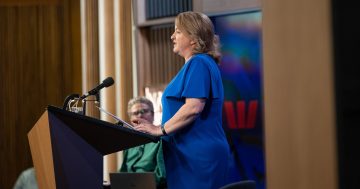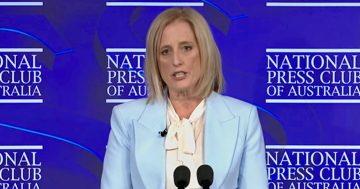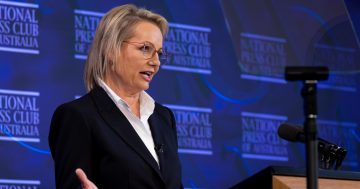Brian J. Lucas, Laura M. Giurge, Zachariah Berry, and Dolly Chugh* say progress toward gender equity in certain industries and in leadership roles has been gradual, but there is one simple way to speed up the process.
 It’s no secret that certain industries are dominated by men, especially in top leadership positions.
It’s no secret that certain industries are dominated by men, especially in top leadership positions.
A classic example is the tech industry, where only 10 per cent of executive-level roles were held by women in 2020.
Although organisations acknowledge gender diversity issues and express intentions to do better, progress toward gender equity has been incremental at best.
Our latest research, in Nature: Human Behaviour, explores one reason for why noble intentions only go so far: Gender inequities are baked into the structure of the informal recruitment process.
Imagine you’re a hiring manager in the technology industry and are looking to hire someone for a top management position.
Your goal is to move fast and find a top-performing candidate.
You have some promising candidates in mind: one whom you remember from your alma mater’s alumni event, another recommended by your previous mentor, and another whom your cousin recommended to you.
Before you’ve even posted the formal job ad, you’ve created an informal shortlist of candidates who will — intentionally or unintentionally — receive more of your attention and more positive evaluations than those not on your informal list.
Similarly, for advancement opportunities without a formal recruitment process, such as internal hiring and promotions or access to training and resources, those on the informal shortlist will be the final candidates considered.
One problem with informal shortlists for male-dominated roles is that the prevalence of men in those jobs lead people to automatically think that men are more suitable for the roles than women.
Consequently, when people think about candidates who would be a good fit for those jobs, male candidates are more likely to come to mind over equally qualified female candidates.
In other words, an informal shortlist may have more male candidates than equally qualified female candidates simply because men come to mind first.
Taken together, informal shortlists pose a particularly daunting barrier to gender equity because they dually suffer from the systemic bias of informal, network-based recruitment and from the implicit bias of selecting top-of-mind candidates in gendered roles.
Our research identifies a simple way to attenuate this gender bias: make your informal shortlist longer.
The longer shortlist
To test this idea, we conducted three initial studies with 858 adults in which participants imagined being a filmmaker who wanted to recruit a lead actor for their upcoming action-thriller film that was “packed with action, car chases, and shoot-outs.”
As is common with informal recruitment processes, we asked participants to generate a shortlist of three names for potential candidates (the initial list).
However, unlike traditional informal processes, we next asked participants to expand their three-person shortlist by adding three additional names (the extended list).
Across these studies, we found that the number of female candidates listed was 33 per cent higher in the extended shortlist compared to the initial shortlist.
Whereas the initial list contained a 1:8 ratio of women to men, the extended list contained a 1:6 women-to-men ratio.
We replicated this effect in two additional studies with 265 adults who had working experience in the technology industry.
In these studies, participants imagined working at a technology startup in California that was looking to recruit a new CEO.
Again, we first asked participants to generate a list of three potential candidates and then to expand this list by adding three additional names.
We found that the extended shortlist contained 44 per cent more female candidates than the initial shortlist (a 1:6 women-to-men ratio in the initial list and a 1:4 women-to-men ratio in the extended list).
Why creating a longer shortlist increases gender diversity
To understand why the longer shortlist works, we turn to creativity research that demonstrates how the mind generates ideas.
This research finds that persistence on creative tasks can result in more creative ideas.
This occurs because the more time people spend brainstorming about a given problem, the more likely it is that the ideas they generate will diverge from the status quo, a key ingredient of creativity.
We argue that the longer shortlist operates via a similar process: it contains more female candidates because it pushes people to spend more time and generate alternatives that diverge from the gender prototype (women for male-dominant roles).
We tested this mechanism in a domain that has both male and female gender prototypes: role models for children.
Given the tendency for parents to think of men as suitable role models for their boys (e.g., Bill Gates, Martin Luther King Jr.), role models for boys is a male-prototyped domain.
Parents also tend to think of women as suitable role models for their girls (e.g., Marie Curie, Michelle Obama), making role models for girls a female-prototyped domain.
We asked parents with a child five years old or younger to list three role models for their boy or girl and then extend this list with three more names.
Among parents of boys, we found that the extended shortlist had more female role models compared to the initial shortlist. This is consistent with our prior studies.
We found the opposite pattern among parents of girls: the extended shortlist had fewer female role models compared to the initial shortlist.
Thus, consistent with the gender prototype explanation, when the role was prototypically female (as in role models for girls), making a longer shortlist did not increase the number of women listed.
Shortlist length and candidate selection
If a longer shortlist leads more female candidates to be listed, does this make a difference when it comes to candidate selection?
To answer this question, we conducted two final studies.
One study recruited 240 university students to complete the Hollywood action thriller task, and the other recruited 2,166 adults with technology industry experience to complete the technology executive task.
In both studies, we randomly assigned participants to create either a three-person shortlist or a six-person shortlist.
We then asked participants to rank the candidates in order of preference for selection.
In both studies, we found that participants asked to generate a longer shortlist listed more female candidates than those asked to generate a shorter shortlist, both in terms of quantity and proportion of female candidates.
When it comes to candidate selection, we found that listing more female candidates was positively correlated with selecting more female candidates.
However, although more female candidates were selected from the longer shortlists (20 per cent) than from the shorter shortlists (17 per cent), this mean difference was not statistically significant.
This result suggests the need for further research to reveal strategies to help ensure those in the longer shortlist receive full consideration.
In short: Aggregating across studies (N = 3,308), we found that making the shortlist longer increased the proportion of female candidates from 15 per cent to 20 per cent — that is, from a 1:6 ratio of women to men to a 1:4 ratio of women to men.
Managerial implications
Next time you make an informal shortlist, particularly for a leadership position or a job in a male-dominated role, take some extra time to extend your initial list.
Our research across 10 studies with diverse samples and contexts shows that adding a few more candidates can increase the gender diversity of your shortlist and reduce the odds that you’ll shun qualified female candidates simply because male candidates come to mind first.
But also remember that achieving gender equity is a complex issue with complex solutions.
We view the longer shortlist intervention as one way to make the informal recruitment process less prone to both systemic and implicit bias.
However, the informal shortlist is just one step in the recruitment process, which also includes formal recruitment and interviews.
We encourage managers to consider the longer shortlist intervention alongside other interventions and initiatives designed to promote gender diversity along the professional advancement pathway.
*Brian J. Lucas is an assistant professor of organisational behaviour at Cornell University’s Industrial and Labor Relations School.
Laura M. Giurge is a postdoctoral research fellow in the organisational behaviour department at London Business School, and the Barnes Research Fellow at the Wellbeing Research Centre at the University of Oxford.
Zachariah Berry is a PhD student in organisational behaviour at Cornell University’s Industrial and Labor Relations School.
Dolly Chugh is the Jacob B. Melnick Term Professor at New York University Stern School of Business.
This article first appeared at hbr.org.











